|
Stein
Collectors International
|
|
~Mettlach Beer
Steins: An Introduction~
by Walt Vogdes
|
 |
|
This article provides an
introduction to beer steins
which were produced by Mettlach in their "golden age" of stein
production between 1885 and 1910. Mettlach is easily the best known
name among
manufacturers of old beer steins, and to collectors the name is
synonymous with
quality and value. To be accurate, Mettlach is but one of the multiple
factories
of the company of Villeroy & Boch (V&B), its name being taken
from the
village where it is located. But the name is a very useful one, since
the great
majority of steins produced by Villeroy & Boch and sought by
today’s
collectors were produced in this factory. Moreover, the trademarks
employed on
the base of their wares prominently feature the name Mettlach.
Located on the Saar River in western Germany, close to borders with
Luxembourg and France, the Mettlach factory is housed on the grounds of
a former
Benedictine Abbey dating to the 10th century. The factory was founded
on this
site in 1809 by Johann Franz Boch-Buschmann, and the company of
Villeroy &
Boch resulted from a merger with Nicolas Villeroy in 1836.
Each of several V&B factories designed (and trademarked) their own
wares, and while other factories admittedly produced some high quality
and appealing steins, this article will deal exclusively with those
manufactured at
Mettlach. Further, while Mettlach produced plaques, pokals, beakers,
punch
bowls, pitchers, tobacco jars, vases, dinnerware, ash trays, beer taps,
candlesticks, bottles — the variety seems endless — this article will
stick
with beer steins.
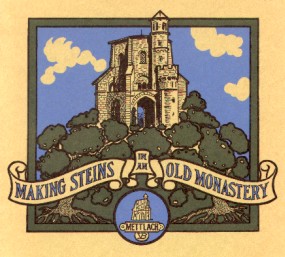 |
| This is the cover of a booklet
authored by E. R. Thieler in
1909, on the occasion of Mettlach's centenary as a pottery. It was
reprinted in
1971 by Stein Collectors International, Inc. |
The Attraction for
Collectors
Mettlach steins have a number of characteristics
which make them an enduring collectible:
- they are well-marked and easily identified
- good reference books are available
- there are many related pairs and sets
- designs are original and creative
- broad variety allows for every taste
- excellent quality control was maintained
- there is a ready market
No one knows how many steins were
produced by Mettlach, but
we do know that at the height of production Mettlach's factory workers
alone numbered over 1250. Allowing for different sizes and design
variations,
Kirsner (The
Mettlach Book) lists over 1500 different steins! He speculates that
average production could have exceeded 2000
examples, noting
that the most common
items certainly had far more, while some had far less.
While we might be tempted to speculate that the majority of this
production
remains in Germany, this is a very shaky conclusion. In addition to
normal
breakage over time, huge quantities of these examples of German culture
were
intentionally destroyed by conquering forces after each of the two
World Wars.
Mettlach wares became well known in the US following exhibitions in
Philadelphia
(1876) and Chicago (1893), and US collections provided a safe haven
during the
war years. As a result, a significant portion of the existing Mettlach
pieces
are in the US.
More important to today’s collector than the original production
quantities is the quantity which remains intact. Although in a few
cases only
one or two examples are known, the majority of items are more common,
with
somewhere between 100 and 500 examples being seen on the American
market.
Types of Steins
The primary "lines" of steins
produced
by Mettlach are briefly described in the following sections. While
reference is
made to production techniques, it must be pointed out that Mettlach
used many
different techniques which were refined over time, and likely altered
these
techniques in producing specific items. Much research has been done to
try to
understand how Mettlach produced these items, and each of the theories
is able
to produce evidence to support it.
While the various categories of Mettlach steins and their markings are
discussed below, it should be noted that the stein type is the
primary
characteristic by which all steins are known. Thus collectors refer to
early wares, tree-trunk, relief, etched, cameo, mosaic, PUG, etched and
PUG, etched and relief,
character, faience, Rookwood, Delft, etc. Note that these terms refer
to the primary area of decoration on the stein, including the
side
decorations,
but ignoring any framework surrounding the decoration as well as the
rim and
base ornamentation. While most of these terms retain their normal
meaning, it must be understood that "cameo," "mosaic," "faience,"
"Rookwood," "Delft" and similar terms refer to visual style, and not to
manufacturing process or material.
|
 "Tree-Trunk"
Relief "Tree-Trunk"
Relief
The early (pre-1880) stein
production by Mettlach
was generally limited to a relief "tree trunk" style, where the body
was molded with the appearance of a tree trunk, and leaves and vines
were added
in relief. These steins, also called "early wares", were frequently
highlighted with shiny platinum. Comprising a very small fraction of
the total
stein production of Mettlach, these early pieces are largely ignored by
today's
collectors. The construction of a railroad along the Saar River,
together with
new production techniques and an emphasis on the best artistic
standards of the
past, allowed Mettlach to introduce several new lines in the years
following
1880. These wares, featuring extensive use of color, were termed
"frankly
unrivaled" at the 1885 World’s Fair in Antwerp, bringing Mettlach
worldwide renown and stimulating vigorous production.
Roy D Selms provided a Featured Stein article for March 2013 which
featured the stein shown at right, and discussed this stein and the
early Mettlach marks.
|
"Etched"
or Chromolith (colored stone)
Each of these terms refers to a specific manufacturing process. Because
the items produced by each process are largely similar, the terms are
sometimes used interchangeably—and incorrectly. Both involve creating a
molded design which establishes areas of different color. Areas within
the design are separated
by outlines in a contrasting color. Additional definition is
added the same way. See the gnome's cap in the adjacent photo for a
clear example. Although there are no
surviving records of how
either of these processes was performed, forensic analysis of broken
pieces has provided some insights. In the
chromolith process, which was used prior to 1880, the color of these
lines is created by filling them with colored clay slip, resulting in a
completely smooth surface. The chromolith process was no longer used
post 1880, as it required special equipment and proved too labor intensive and costly for mass production.
Chromolith form numbers are restricted to the 800s, and there are no chromolith steins. The
successsor to the chromolith wares is the "etched" line.
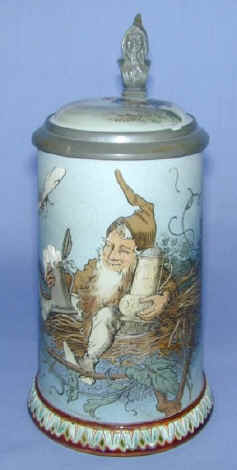 The "etched" wares are very
similar in appearance to chromolith items, but employ a
significantly different technique, principally with regard to the
outlines—on the
etched ware these lines were made by
rubbing a black glaze into the "incised" lines. As a result, the lines
are easily felt with a finger nail. The "etched" wares are very
similar in appearance to chromolith items, but employ a
significantly different technique, principally with regard to the
outlines—on the
etched ware these lines were made by
rubbing a black glaze into the "incised" lines. As a result, the lines
are easily felt with a finger nail.
The large background areas of many "etched" pieces show shading which
could not be achieved with a uniform area of clay slip. This was
created by using some form of atomizer to add color shading within the
mold before adding adding the clay slip. This artistic embellishment
makes the backgrounds more natural. At the same time, it also
introduced some level of variation from piece to piece which should be
accepted as intentional. Gary
Kirsner discusses these topics in greater detail in The Mettlach Book.
This is a good place to point out that while the terms "incised" and
"etched" reflect the appearance
of these wares, they are incorrect as regards their manufacture.
The stein shown to the right (form 2134) is a favorite among fans of
artist/ designer Heinrich Schlitt. It is commonly referred to as the
"gnome
in a nest". The inlaid lid shows a rooster at sunrise.
The most common and most popular themes for etched steins include
scenic
illustration -- tavern scenes, castles, the Munich Child, medieval
scenes, etc.
However, a number of steins were made with abstract designs, and these
are
generally known by another name. "Art Nouveau" steins feature the
flowing lines and geometric patterns of that style, although they are
still
executed with in the etched technique. "Mosaic" steins involve a
repeating pattern comprised of many small sections of colored clay.
While
bearing many similarities to etched steins, they evidence some of
the
characteristics of relief, and are generally more complex in their
style. |
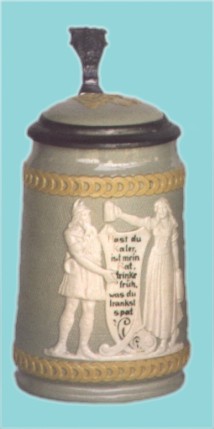 Relief Relief
At about this same time Mettlach
began to
introduce relief steins using either applied or molded relief
decoration. The
decoration was typically light in color against a darker color on the
body,
frequently blue or terra cotta (shown to the right with a greenish-gray
background). The relief coloration was set by the color of the clay.
Applied
relief designs were formed using a flat mold, then applied on top of
the
undecorated body before firing. Molded relief pieces were formed by
pressing the
white clay into recesses in the form before the colored clay was added
for the
body. These steins are similar in appearance to Wedgwood Jasperware,
although of
higher quality and finer detail. A later innovation involved the use of
full
color relief decoration, but the production of relief steins never
approached
the volume of etched steins.
|
Cameo
and Phanolith
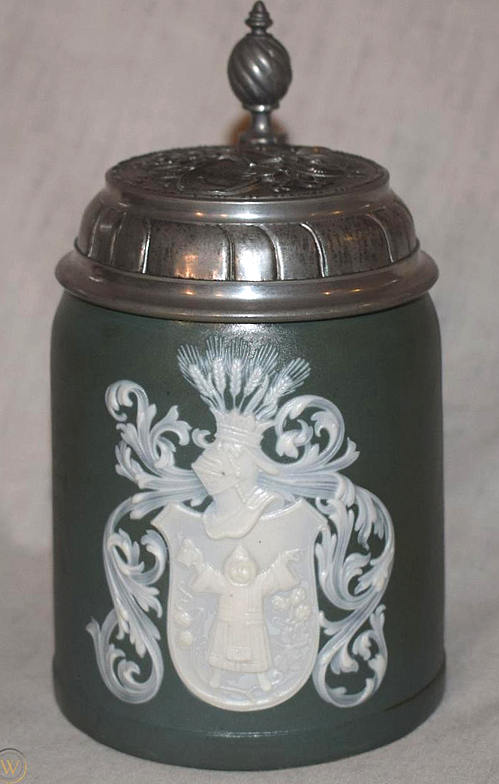 Cameo
and phanolith items have a similar initial appearance to relief items,
but use higher quality materials for the relief design to create a
translucent effect similar to shell cameos,
and to provide a finer degree of detail. Whereas relief steins are
commonly glazed, the cameo and phanolith decorations are unglazed, or
bisque. Cameo items most often used a sea-green background, and less
commonly a dark blue color. The backgrounds were unglazed as well.
Cameo steins were given form numbers in the 2000’s and 3000’s. The
cameo stein at left is form 2949. Cameo
and phanolith items have a similar initial appearance to relief items,
but use higher quality materials for the relief design to create a
translucent effect similar to shell cameos,
and to provide a finer degree of detail. Whereas relief steins are
commonly glazed, the cameo and phanolith decorations are unglazed, or
bisque. Cameo items most often used a sea-green background, and less
commonly a dark blue color. The backgrounds were unglazed as well.
Cameo steins were given form numbers in the 2000’s and 3000’s. The
cameo stein at left is form 2949.
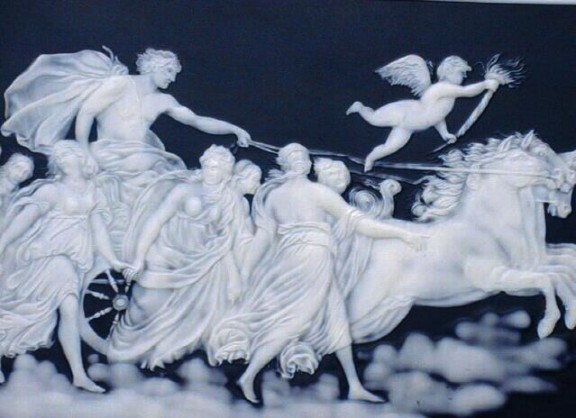 It's
important to realize that cameo and phanolith processes were distinctly
different. The term "phanolith" denotes plaques, vases and jardinieres
which were made from soft-paste porcelain and exhibited translucency in
both the bodies and decorations. There were no phanolith steins made
and all phanolith items were numbered in the 7,000's. The figure shown
here is a very finely done phanolith plaque of modern manufacture.
Because the detail of these items is essential to understanding how
they differ from standard relief pieces, you may click anywhere on the
image to see a larger version. It's
important to realize that cameo and phanolith processes were distinctly
different. The term "phanolith" denotes plaques, vases and jardinieres
which were made from soft-paste porcelain and exhibited translucency in
both the bodies and decorations. There were no phanolith steins made
and all phanolith items were numbered in the 7,000's. The figure shown
here is a very finely done phanolith plaque of modern manufacture.
Because the detail of these items is essential to understanding how
they differ from standard relief pieces, you may click anywhere on the
image to see a larger version.
|
 Print Under Glaze
(PUG) Steins Print Under Glaze
(PUG) Steins
In 1886 Mettlach initiated use of a transfer technique for decorating a
less-costly line of products based upon a process employed by the
English. This
involved the use of lithographed designs on metal plates, which then
transferred
the full-color design to a paper "transfer". The stein body was glazed
and fired, then the transfer applied, followed by another clear glaze
and final
firing. There are also a number of Mettlach PUG steins on which the
transfer
consisted of only an outline of the design, and the colors were
handpainted.
Unlike other Mettlach lines, PUG decorations are flat on the body and
smooth to
the touch, and the steins have a glossy glaze finish. Because they
required
significantly less handwork, the simple half-liter PUG bodies
originally cost
about one third as much as the half-liter etched bodies, although with
the
addition of a pewter lid they were about half as costly. Interestingly,
the
pewter lid for a simple half-liter PUG cost more than the body alone!
The use of transfer decoration meant that a unique mold was no longer
required. A large variety of decorations were applied to the same body
form
number. Forms 1526 and 1909, in both ½-liter and one liter sizes, were
the most
commonly used, although there were many others. In some cases the same
design
was used on more than one body. Whereas etched and other types of
steins are
generally known by the form number, PUG steins are known by the
combination of
decoration number followed by form. As an example, the ½-liter PUG
stein
illustrated here, decoration number 591 on body form 1526, is commonly
referred
to as "591(1526)". |
Specialty types
At various times Mettlach produced steins which had the same decorative
style as other manufacturers or periods, including Delft
designs, faience and Rookwood.
The Mettlach "Rookwood" steins were similar in general appearance to
standard-glaze portrait items produced at the Rookwood factory in
Cincinnati,
OH. The outline of the decoration for these items was put on the body
using a
printed transfer, and the decoration was finished by hand. The Mettlach
Rookwood
steins, all of which are portraits, were made with a fancy "carved"
pewter lid, many with a large ball thumblift, reminiscent of lids from
an
earlier period. Many of the faience and Delft steins also came with
these lids,
and some of the faience steins included a pewter footring. |
The BAVARIA Line
This line of transfer-decorated steins, bearing the incised word
BAVARIA as
part of the trademark, appeared in the catalogue of 1906. These steins
were
simpler in their body shapes and overall decorative techniques, making
them
compliant with emerging trends of the Jugendstil period, while
simultaneously making them less expensive. |
Special Orders
Mettlach produced many steins to special order, for both domestic
purposes
and for export. In fact, many steins bearing German phrases or verses
can also
be found in an English-language version. While we might suppose that it
would be
prohibitively costly, the existence of a sizable number of such pieces
indicates
that it was not. Well-known examples of special orders include an
etched stein
for St. Augustine, Florida, which includes a figural alligator handle,
three
steins produced for Cornell University, and the Quilmes Brewery
(Argentina)
stein. |
Handpainted Steins
True handpainted designs were used for many custom decorated steins,
and
they frequently carry silver presentation lids. While some of these may
have
been decorated in the factory, more commonly they were commissioned to
local
artists who worked on either flat or relief matte-finish bodies
especially
purchased for this purpose. Although there are a wide variety of
hand-painted
themes, the most common examples are probably steins decorated with
student
crests or wappen. These steins are frequently marked on the
base or on
the rear of the body to identify the decorative firm. |
 Sizes Sizes
While the vast majority were 1/2 or 1 liter in capacity, Mettlach
produced
steins ranging in size from 0.05 liter (very few, PUG decorated) to 7.0
liters
(only one, etched #1161). This etched giant (left), standing 21" tall
and
weighing
about 11 pounds -- empty -- is signed "C. Warth". The design features
two ladies in Victorian costume holding foaming steins of beer, with an
Imperial
German Eagle above a very typical incised German verse:
Gerstensaft
mit Hopfen
credenzt
von schoner Hand
sind jedem
Wundertropfen
im weiten
deutschen Land.
Juice with hops,
Served by a
beautiful hand,
Are
everyone’s wonder drops,
In all of
Germany’s land.
With figural stoneware inlaid lid this stein cost 40 DM in 1885, making
it
the most expensive stein offered by Mettlach. The body without lid cost
30 DM,
for which sum one could purchase 7 or 8 etched steins with inlaid lids.
|
Lids
Most collectors today feel that without a lid, a stein is incomplete.
This
is especially true for Mettlach, since a very large number of the
steins had
stoneware inserts (inlays) in a pewter ring designed to match or
complement the
body. While Mettlach steins could originally be ordered without lids,
those
steins were in the clear minority.
The various types of lids originally accompanying Mettlach steins
include
figural (three-dimensional), etched inlay, PUG inlay, fancy pewter,
simple domed
or low-relief pewter (the most common lids on PUG steins) and
presentation lids
(usually silver or silver-plated and probably added to a specially
ordered
lidless piece). Etched steins bore either etched inlaid lids, figural
lids or
pewter lids. The "Occupational series" provides an excellent example
of etched lids which complement the themes on the bodies of the steins.
PUG
steins were made with either PUG inlays or pewter lids. While pewter
lids were
more expensive and more prized than many of the stoneware inlays during
the
height of Mettlach production, that appeal has been reversed for modern
collectors.
Mettlach Artists
Mettlach employed a large number of
artist/designers, among them
some of the most prominent of their time. Most prolific among them were
Heinrich
Schlitt, Otto Hupp, Fritz Quidenus, Christian Warth, Johann Baptist
Stahl, and
M. Hein. Other notable artists who designed steins for Mettlach include
Ludwig
Hohlwein, Franz Ringer and Richard Riemerschmid. A large number of
steins,
although still the minority, carry the name or initials of these
artists as
"signature". Many unsigned steins can still be attributed to the
artist who conceived of their design. The works of Heinrich Schlitt, a
very
famous Munich artist who designed murals in many public facilities, is
a
favorite of Mettlach collectors. Many of his works feature fun-loving
gnomes or animals engaged in human pasttimes. The steins designed
by Ringer, Hohlwein, Hupp and Riemerschmid are also highly coveted by
collectors
for their artistic execution.
Recognizing Mettlach
Steins
While many Mettlach collectors can spot a Mettlach stein across a room
without having to examine it, the easiest way to identify Mettlach
wares is by
the trademarks which appear on the bottom of the vast majority of the
steins.
(For illustrations of Mettlach marks, see the article in the Library
entitled
"Mettlach Marks: The Basics".) Most Mettlach steins produced
between 1885 and 1910 bear one or both of two trademarks: the incised
abbey
tower (sometimes incorrectly called "the castle mark") and/or some
variant of the stamped Mercury mark. The tower mark is actually two
separate
marks -- an incised representation of the old abbey tower above a
banner
carrying the name Mettlach and the monogram V&B. The Mercury mark,
usually
stamped in green but known in blue, brown and black as well, shows
Mercury, god
of commerce, over a straight center panel with the words "Villeroy
&
Boch" and a semi-circular band identifying the Mettlach factory. (The
variations of this mark serve as a dating system, but that goes beyond
the scope
and purpose of this article.)
In addition to a trademark, several other markings typically appear on
the
base of Mettlach steins, the most important being a three- or
four-digit incised
form number, and in the case of the PUG, Delft and Rookwood steins, a
stamped
decoration number. Other marks include a Roman numeral indicating the
size, a
two-digit number indicating the year, and various quality-control
marks. Steins
manufactured for export may also be marked "Made in Germany", or even
Reg. U.S. Pat. Off.
Some Mettlach steins are found without trademarks, but in many cases
the
maker can still be confidently identified as Mettlach. If the incised
mold
number or the stamped or painted decoration number is present it may be
used to
look up the piece in a Mettlach reference book. If the mold number
cannot be
found, or if it is partially obliterated, the digits should be compared
with the
distinctive appearance of known examples. Other typical marks -- the
size
number, the year, the quality control number -- are useful to imply
Mettlach.
The inside should show a characteristic bright white glaze, similar in
appearance to porcelain. Above all, the decoration appearing on the
stein should
be exceptionally clear and clean, and the stein should show overall
excellence
in design and quality of production.
Summary
Mettlach, one of several factories of the Villeroy & Boch ceramics
company, was the most prodigious of all stein manufacturers between
1885 and
1910, sometimes called "the golden age of beer steins". Their wares
are readily identifiable by quality, style and artistry, as well as by
very
thorough base marking. Steins were produced in a variety of different
lines,
including the following:
"early wares" - applied relief, frequently tree-trunk motif,
used platinum highlights
etched - full color, normally matte finish, detailed designs where the design
is flat but detail and color separation is provided by incised
black
lines which can be felt by fingertip
relief - the primary design is presented in relief in one color
against a contrasting body color, or later, a full color relief design
cameo - similar to relief, but the decoration is an unglazed,
translucent
porcelain- like material against a sea-green or dark blue background
(form
numbers in the 2000’s)
PUG - the design, made from a printed transfer under the glaze, is
smooth to
the touch and has a shiny finish, the design number should be stamped
on the
bottom of the stein along with the incised mold number (the most common
mold
numbers are 1526 and 1909)
The name Mettlach would not be nearly so well known were it not for the
artistic merit and the consistently high quality of their ware. It is
not a
coincidence that the manufacturer with the best designs and the best
production
techniques was also the most prolific producer of beer steins. The
large volumes
produced by Mettlach, the variety of decorative themes and techniques,
the
number and quality of the artists they employed, the willingness to
experiment
and their continual innovation -- both artistic and technical -- give
ample
warning: while we can analyze and theorize to great lengths, Mettlach
broke more
rules than they followed, and new examples continue to surface.
References
History of Villeroy & Boch - http://www.villeroy-boch.com/History.246.0.html?&C=GB&L=en
Kirsner, Gary, 1987, The Mettlach Book, Glentiques Ltd., Coral
Springs, FL.
Prosit, quarterly publication of Stein Collectors
International, 1965
to present (numerous articles displaying growing knowledge and theories
about
Mettlach wares, techniques and artists).
Thomas, Dr. Therese, and Post, Anton, Villeroy & Boch Mettlach
1885 -
1905, Hans J. Ammelounx, Wheeling, IL, 1975
Thieler, E. R., Making Steins in an Old Monastery, booklet
reprinted
by Stein Collectors International in 1971
KERAMIK 6, Buchverlag J. Büchel,
Triesen/Lichtenstein (German and English). |
|
|